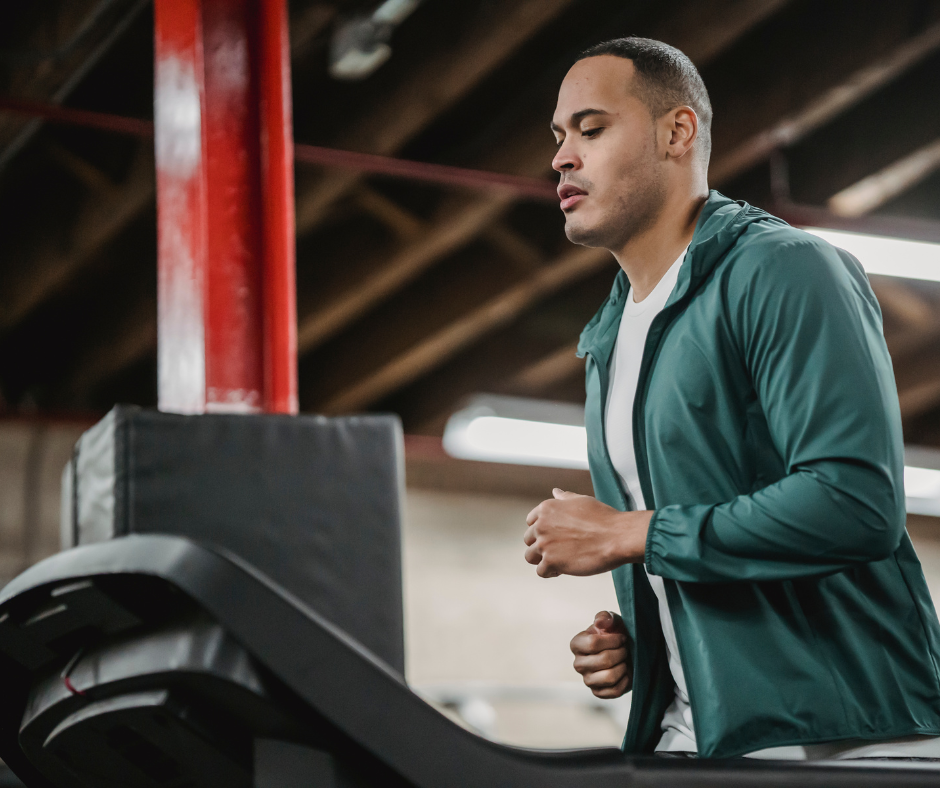It is possible to train for the New York City Marathon on a treadmill, but it may not be the most optimal way to prepare for The New York City Marathon, that is unless you make the necessary changes to your training to compensate for the lack of outdoor runs.
Treadmills can be a useful tool for building endurance, practicing pacing, and avoiding unsafe outdoor conditions…
In this article, we are going to have a look at ways you can replicate the varied terrain and environmental factors of running outside while training on a treadmill for the New York City Marathon…

The Difference Between Running On a Treadmill & Outdoors
The good news is that recent research shows that running on the treadmill is roughly the same as running outside if you make a few small adjustments to your treadmill workout.
Treadmills are used inside, making it easy to run at home or in the gym regardless of weather conditions or even the time of day outside.
A common challenge for runners who train on treadmills due to different reasons is that without the changing terrain or scenery, the runs can get quite boring.
I know that when I run on a treadmill, I may feel like I’ve been running for about 30 minutes but when I look down and see the timer only says 8 minutes, my heart sinks a little…
With that being said, running on a treadmill and running outdoors both have their perks and downfalls…
Let’s have a look at the positives and negatives of training on a treadmill…
Positives Of Training On a Treadmill:
1. Same Level of Energy Extended: Running at a 1% incline on the treadmill expends the same energy costs as running outdoors.
2. Safety: On a treadmill, you don’t have to worry about cars, bikes, or pedestrians, and you probably won’t feel the need to carry pepper spray with you.
3. Race Simulators: Some treadmills can simulate the race you are training for so that you can get used to the route as much as possible, for example, The New York City Marathon route.
4. Injury Prevention: Running on a treadmill is easier on your joints as the belt is cushioned to absorb shock, unlike the road or trail. (This isn’t true for all treadmills though, only super expensive ones)
5. Convenience: On a treadmill, you can train anytime, day or night, listen to music in your headphones as loud as you like, watch any Netflix series you like and you can also keep water and nutrition close by.
6. Weather Conditions: On a treadmill, you don’t need to worry about snow, hail, or rain.
7. Prescribed Paces: It’s easier on a treadmill to set your required pace and stick to it.
8. Gradient: You can set the gradient to be specific for your hill repeat sessions. This way you are certain you are not running on a hill steeper than 5-6% (Steeper than 6% has inherent injury risks)
9. Builds Mental Toughness: Time feels like it ticks by slower on a treadmill therefore it becomes a bit of a mental challenge to stay focused and motivated.
Although there are so many positives, for many people, running on a treadmill is just dreadful… hence the term… “dreadmill”.
Let’s have a look at why this may be the case…
Negatives Of Training On a Treadmill:

- When training on a treadmill you are receiving a small amount of help from the belt. As a result, your hamstrings & glutes won’t get the same level of adaptation as they would if you were running outdoors.
- Running on a treadmill doesn’t create the challenge of having to practice your balance and coordination like running outdoors does.
- It can become mind-numbing… For some, no matter their playlist or choice of tv show… time ticks by a lot slower when training on a treadmill.
- Your chances of getting an overuse injury increase on a treadmill because of the repetitive motion and lack of variety in terrain. This is especially true for lower limb ligament and tendon issues such as Achilles tendinopathies
- There is a lack of social running because training on a treadmill means you aren’t able to run with your club or buddies.
- Training on a treadmill usually means you can’t run downhill at all in your sessions, it also means you don’t get any training practice while experiencing different weather conditions which may backfire come race day.
(Note: Some modern treadmills allow for slight downhill running) - You miss out on running outside which has shown to be very helpful for mental health, especially when running in nature
Ultimately, even though running outdoors provides so many benefits, running on a treadmill has its advantages, too. So it comes down to your preference and opportunities… If you dont have the luxury to train outside then the treadmill is the next best option to get you through your marathon
If that’s the case, then this is how you should go about it…
How To Train For The New York City Marathon On a Treadmill
12 weeks of training on a treadmill for the New York City Marathon is more than enough time to train, even if you’re a beginner with only a little running experience.
All of the runs in this training program can be completed on a treadmill as long as you stick to the pace guidelines in the plans and incorporate the adjustments we cover below.
The training plans are specific to your level of experience so that all you have to worry about come race day is crossing that finish line…
The New York Marathon Training Roadmap
What you do in the 12 weeks leading up to the New York Marathon will either set you up for success or failure…
Ensure your success with 12 weeks of access to the Coach Parry New York Marathon Training Roadmap.
Treadmill Training Adjustments For The New York City Marathon
Long Runs
Long runs are vital to you completing the New York City Marathon. The purpose of a long run is to achieve several outcomes, the most important is to develop your endurance to be able to supply energy and oxygen to working muscles over longer distances.
The long run, therefore, plays an important role in improving the running economy.
Long runs teach us to be on our feet for a long time and they physiologically prepare us for going longer distances. They also allow us to experiment with different nutrition to find out what works best and what doesn’t work for our stomachs., so that we’re ready for race day
Treadmill adjustment:
Stick to what your training plan says in terms of pace but put the treadmill on a 1% incline. (Remember these runs are meant to be run at a very easy pace.) Here’s why.
Note: Treadmills differ and pacing may vary slightly. That’s why it’s important to focus on running at an easy effort. Your GPS watch may have an inside treadmill function but this is not very accurate indoors so its best to rather work on perceived exertion and keeping those runs EASY
Completing your long run training on a treadmill might take some getting used to at first, we suggest creating a playlist of your favorite songs or putting on your favorite shows to help pass time.
Interval Training & Hill Intervals
Interval training involves a series of rest and running intervals for a controlled duration.
Hill interval sessions improve runners’ muscular and cardiovascular strength and increase their speed and running economy.
Treadmill adjustment:
0% incline for most intervals and 3-5% incline for hill intervals. (Advised to start at 3% and build to 5% as you progress and if you find 3% is getting too easy.)
Some people find it more difficult and others enjoy it, so I would pay attention to how you are feeling, and if it feels harder than usual then please slow down.
Be sure to follow the warm-up instructions before jumping into the session.
A warm-up should consist of some easy running, a few builds, strides, and/or running drills.
(You can grab our free running drills flow by clicking here)
When doing hard training sessions such as intervals, hills, track, or time trials it is important to do a good 15-20min warm-up and to include some dynamic stretching.
For easy, recovery and long runs it is sufficient to start nice and easy for 5-10min before settling into your stride for the rest of the session.
Let’s have a closer look at some dynamic stretches…
Time Trials
Time trials are scheduled every four-six weeks in your program depending on what program you are on. You can use these as an indicator of your progress and adjust your program if necessary.
The time trials can be 5km or 8km depending on your goal race and should be run at an all-out effort, in the best time possible.
Treadmill adjustment:
Select a 1% incline for time trials.
The SECRET Session That Makes You Run FAST
The toughest part of training on a treadmill for a marathon is completing your long runs… let’s dive a bit deeper into this…
Is It Ok To Do a Long Run On a Treadmill?
It is perfectly alright to do your long-run training for the New York City Marathon on a treadmill. Research has proven that setting the treadmill to a 1% gradient accurately reflects the energy costs and simulates outdoor running.
That 1% grade offsets the lack of wind resistance and makes your treadmill sessions the same effort as running outdoors.

The distance of your longest marathon training run will be depicted in your training plan and based on your New York Marathon time goal as well as your experience and time trial times.
To avoid boredom on your long runs we suggest experimenting with different tactics to help pass time.
One of the massive benefits of doing your long runs on a treadmill is the easy availability of nutrition and water… these need to be practiced before race day so make sure to have your race fuel at easy reach.
There is always doubt when it comes to wondering if you are prepared enough for the big day… Here are our top 14 Marathon training tips for those of you who will be training on a treadmill…
14 Treadmill Marathon Training Tips To Help You Prepare For the New York City Marathon
- Getting through long runs can be especially tough, fight the boredom by creating motivational playlists, listening to podcasts, watching your favorite tv shows, or even setting little challenges for yourself.
- Follow a New York Marathon Training Plan, this will help you prepare for the race by advising on the correct paces you need to be running.
- Don’t step on or off while the treadmill is moving, this is a big cause of treadmill injuries and can be avoided by pausing your run if you need a water or loo break and then continuing once you are back.
- Always warm up, you can briskly walk for 5 minutes, add some dynamic stretching or slowly jog before setting the treadmill to the required pace. This video will help!
- Treat your long runs as you would if you were outside, and wear the gear you plan to wear on race day so that you get used to running in it. Eg. hats and sunglasses. (Don’t worry about what people may think of you)
- Practice the nutrition you plan to use on race day, practice your hydration strategy, and walk breaks.
- Listen to your feet hitting the treadmill mat, running on the treadmill allows you to listen to how your feet are landing, you should try to maintain a light footfall.
- The pace of your easy runs should be easy enough to hold a conversation. If you can’t find a treadmill buddy, call a friend and talk on a hands-free headset or Bluetooth headphones. If no one wants to chat with you, you need to be able to burst into song without getting out of breath. That’s one way to keep yourself busy while on the treadmill 😉
- Don’t hold on to the handrails, they are only there to help you get off and on the treadmill.
- Keep your head up and look ahead… not at your feet. Watching your feet will strain your neck and could cause unbalance and risk of injury.
- Give yourself enough room on the treadmill for a normal arm swing… Don’t stand too close to the front of the machine.
- Pay attention to your stride, you should be running on the treadmill the same way you would run outdoors.
- Cool down after your session by walking slowly for a few minutes. If you don’t you may feel dizzy as if you’re still moving when you step off the treadmill.
- Level your machine if it’s at home. Having an unleveled treadmill is a sure way to pick up a running injury without even knowing it.
Now we know that it is possible to train effectively for the New York City Marathon on a treadmill. In this article, we tell you all about what you can find along the New York City Marathon route.



Comments are closed.